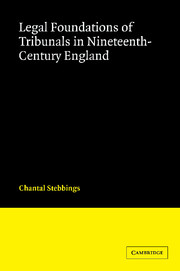Book contents
- Frontmatter
- Contents
- Acknowledgements
- Table of statutes
- Table of cases
- List of abbreviations
- 1 Challenges to the legal process
- 2 The ideological and theoretical context
- 3 Composition and personnel
- 4 Jurisdiction and functional powers
- 5 Procedure and practice
- 6 Judicial supervision
- 7 Principles, place and perception
- Index
2 - The ideological and theoretical context
Published online by Cambridge University Press: 02 December 2009
- Frontmatter
- Contents
- Acknowledgements
- Table of statutes
- Table of cases
- List of abbreviations
- 1 Challenges to the legal process
- 2 The ideological and theoretical context
- 3 Composition and personnel
- 4 Jurisdiction and functional powers
- 5 Procedure and practice
- 6 Judicial supervision
- 7 Principles, place and perception
- Index
Summary
The withholding from the regular courts of law of the dispute-resolution duties associated with the administration of the new reforming legislation of the early Victorian period was due to the various inadequacies of those bodies to take on novel and challenging functions. It was not, however, the most radical aspect of the legislation. The real novelty lay in the character of the legislation itself as interventionist, centralist and increasingly collective. It was interventionist in that it was founded on the principle of the state regulation of activities that had hitherto been regarded as private. It was centralist in that both in substance and in its machinery of implementation, including the embedded duty to hear and determine disputes arising in the course of its execution, it imported the control of the central government in Whitehall rather than in local government. This was either directly through an organ or agency of the executive based in London or through its own subordinate officers in the provinces. Finally it was collectivist in that it placed the wider good of the community above the interests of the individual.
While it could correctly be stated that in 1900 government interfered hardly at all in the way people ran their daily lives, that assertion was relative: compared with the present day it was undoubtedly true, but compared with 1800 it was undoubtedly not. Scholars now agree that the interventionist state was no twentieth-century phenomenon, but was formed in more than mere outline at a considerably earlier date.
- Type
- Chapter
- Information
- Legal Foundations of Tribunals in Nineteenth Century England , pp. 73 - 109Publisher: Cambridge University PressPrint publication year: 2007



